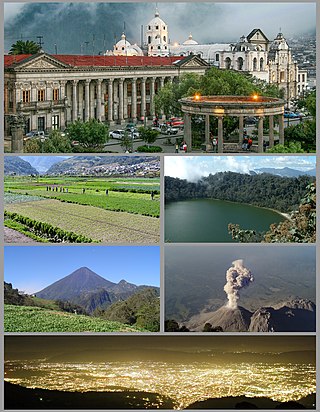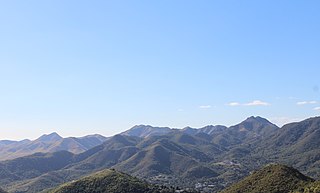
El Mirador is a large pre-Columbian Middle and Late Preclassic Maya settlement, located in the north of the modern department of El Petén, Guatemala. It is part of the Mirador-Calakmul Karst Basin of northern Guatemala.

Quetzaltenango is a department in the western highlands of Guatemala. The capital is the city of Quetzaltenango, the second largest city in Guatemala. The department is divided up into 24 municipalities. The inhabitants include Spanish-speaking Ladinos and the Kʼicheʼ and Mam Maya groups, both with their own Maya language. The department consists of mountainous terrain, with its principal river being the Samalá River. the department is seismically active, suffering from both earthquakes and volcanic activity.

The Galician or Galician Mountain Horse, Spanish: Caballo de Pura Raza Gallega, Galician: Raza Equina Cabalo Galego do Monte, is a breed of small horse from Galicia, in north-western Spain. It is genetically very close to the Garrano breed of northern Portugal. It was in the past used as a war-horse and in agriculture; it is now raised principally for meat. The horses are bay or black.
The Ministry of Environment and Energy is a ministry or department of the government of Costa Rica.

Ordesa y Monte Perdido National Park is an IUCN Category II National Park situated in the Pyrenees. There has been a National Park in the Ordesa Valley since 1918. Its protected area was enlarged in 1982 to cover the whole region, amounting to 156.08 square kilometres.

María Dhialma Tiberti was an Argentine writer. Married to the well known scientist Gregorio Baro, she studied at the Escuela Normal Nº1 Mary O’Graham, and later on, literature and history, at the Universidad Nacional de La Plata. She was responsible for the Del Bosque editions, composed of works of other well-known writers, such as Raúl Amaral, Horacio Ponce de León, Ana Emilia Lahite, and María de Villarino, who were all part of the so-called Generation del 40.
Latindex is a bibliographical information system available for free consultation. Established as a network in 1997, the project is based on the cooperation of 17 national resource centers that operate in a coordinated scheme for the gathering and dissemination of relevant information and data on the Iberoamerican journals.

Las Villuercas is a comarca located in the province of Cáceres, western Spain. It belongs to the Autonomous Community of Extremadura.

The Castellana Negra or Gallina Castellana Negra is a Spanish breed of domestic chicken. It is a good egg-laying breed, rustic and disease-resistant. It was formerly widely kept and commercially exploited in Spain. Since the advent of imported commercial hybrid layer chickens and the spread of highly intensive chicken farming methods, it has almost disappeared.

The Euskal Oiloa, Spanish: Gallina Vasca, is a breed of domestic chicken from the autonomous community of the Basque Country in north-eastern Spain and south-western France. It is the traditional rural chicken of the area, a rustic dual-purpose breed of Atlantic type, and differs from Mediterranean Spanish breeds such as the Castellana Negra and the Minorca in several respects: it has yellow legs and feet, red earlobes, and lays brown eggs.

Magnolia silvioi is an endemic species of Antioquia department. Common names include: guanábano de monte, fruta de molinillo, guanabanillo.
María Cristina Pineda Suazo (1954) is a Honduran astronomer, physicist, civil engineer, professor, and scientific investigator. She was Director of the Astronomical Research Center (CEACS-UNAH), and currently serves as dean in the Faculty of Spatial Sciences (FACES) at the Universidad Nacional Autónoma de Honduras. She belongs to several scientific organizations, including the International Astronomical Union (IAU), the Asamblea de Astrónomos de América Central (AAAC), and the Fundación Salvador Moncada para el Avance de la Ciencia. Pineda also serves as President of the National Committee for Astronomy in Honduras.

Andrés Carretero Pérez, Spanish historian, Doctor in Geography and History. Since 2010 he is heading the National Archaeological Museum of Spain.

The Sierra La Culata National Park Also Sierra de la Culata National Park is a national park of Venezuela that is located in the northeastern branch of the Venezuelan Andes, in the states Mérida and Trujillo. It was decreed a national park on December 7, 1989. It has a high mountain climate, with temperatures ranging between −2 and 24 °C, and its surface area is 200,400 hectares (774 sq mi).
Instituto Español de Estudios Estratégicos (IEEE) is the research center about Strategic studies of the Ministerio de Defensa of Spain who is responsible for coordinating, promoting and disseminating the cultural action of the ministry. It is part of the Centro Superior de Estudios de la Defensa Nacional (CESEDEN).
Jenara Vicenta Arnal Yarza, was the first woman to hold a Ph.D. in chemistry in Spain. She was noted for her work in electrochemistry and her research into the formation of fluorine from potassium biflouride. In later years, she was recognized for her contribution to the pedagogy of teaching science on the elementary and secondary levels, with a focus on the practical uses of chemistry in daily life. She was awarded a national honor, the Orden Civil de Alfonso X el Sabio.

Montes Oscuros is a small mountain range located between the Sierra de Cayey and the main Cordillera Central, on the municipalities of Coamo and Salinas in southern Puerto Rico. The mountain range and its environment are protected from urban development through a conservation easement, designated as the Montes Oscuros Scenic Easement.

The former El Cañizar lake was an extensive freshwater wetland located at the bottom of the Jiloca tectonic trench next to the town of Villarquemado, Spain. Its waters covered part of the municipalities of Cella, Santa Eulalia del Campo and Villarquemado, all of them belonging to the Comarca de la Comunidad de Teruel, Province of Teruel, Autonomous Community of Aragón. Before being drained at the beginning of the 18th century, its waters covered 1130 ha with a maximum depth of 2.8 meters and a stored water volume of 18.7 hm3.

Elisa Moreu Carbonell is a Spanish lawyer, legal scholar and professor of law.


















